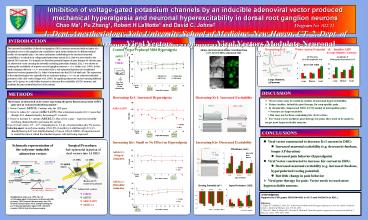36x60 poster template - PowerPoint PPT Presentation
1 / 1
Title:
36x60 poster template
Description:
Adenovirus-mediated inducible gene expression in vivo by a hybrid ecdysone receptor. ... representation of the ecdysone-inducible adenovirus vectors. AdKir2.1: ... – PowerPoint PPT presentation
Number of Views:54
Avg rating:3.0/5.0
Title: 36x60 poster template
1
Inhibition of voltage-gated potassium channels by
an inducible adenoviral vector produced
mechanical hyperalgesia and neuronal
hyperexcitability in dorsal root ganglion
neurons Chao Ma1, Pu Zhang1, Robert H LaMotte1
and David C. Johns2
Program No. 622.21 1. Dept.
Anesthesiology, Yale University School of
Medicine, New Haven, CT. 2. Dept. of
Neurosurgery, The Johns Hopkins Hospital,
Baltimore, MD.
INTRODUCTION
Viral Vectors Modulate Pain Behavior
Viral Vectors Modulate Neuronal Excitability
The increased excitability of dorsal root
ganglion (DRG) neurons associated with an injury
of a peripheral nerve or the ganglion may
contribute to pain-related behaviors in different
animal models of neuropathic pain. One ionic
mechanism contributing to the increased neuronal
excitability is a reduction in voltage-gated
potassium current (Kv), that was also found in
the injured DRG neurons. Kv channels are
therefore potential targets of gene therapy for
chronic pain. An adenoviral vector carrying the
inwardly rectifying potassium channel, Kir2.1 was
shown as reducing the excitability of superior
cervical ganglion neurons in vitro (Johns er al.
1999). In this study, transgene delivery in vivo
was achieved by a sub-epineurial injection of
recombinant adenoviral vectors (prepared by Dr.
Johnss laboratory) into the DRG of adult rats.
The expression of the transferred gene was
controlled by an ecdysone analog in vivo via an
ecdysone-inducible promoter in the viral vector
(Hoppe et al. 2000). By applying adenoviral
vectors carrying different types of Kv genes, we
could either increase or decrease the
excitability of DRG neurons, and modulate the
pain-related behaviors of the animal.
Decreasing Kv1 Wider Action Potential
Smaller AHP in Large-Diameter, A-neurons
Control Vector Produced Mild Hyperalgesia
Sharp-electrode intracellular recordings from
GFP-labeled DRG neurons in vivo.
AdEGI vs. Vehicle
AP Duration (in half amplitude, ms)
Amplitude of Afterhyperpolarization (mV)
Large-Diameter, Ab-neurons
Von-Frey Filaments 100 µm diameter tip
DISCUSSION
METHODS
Decreasing Kv1 Increased Hyperalgesia
Decreasing Kv1 Increased Excitability
- Viral vectors may be useful in studies of
neuronal hyperexcitability. - Future studies inducible gene therapy for
neuropathic pain. - In chronically compressed DRG (CCD) model of
neuropathic pain - Neurons are hyperexcitable
- But may not be those containing Kir viral
vectors - For vectors to be useful in gene therapy for
pain, they need to be made to target most
hyperexcitable neurons.
Three types of adenoviral (Ad) vectors expressing
the green fluorescent protein (GFP) gene and an
ecdysone-inducible promoter 1. Vector Control
(AdEGI) Contains only the GFP gene. 2. Vector to
reduce K current (AdKv1.xDN) Has a
dominant-negative Kv1.3 gene that disrupts Kv1
channels thereby decreasing Kv1 current. 3.
Vector to increase K current (AdKir2.1) Has a
Kir2.1 gene expresses inwardly rectifying
channel thereby increasing Kir current. Dose of
viral vectors 108 1010 viral particles in 2-5
?L of normal saline plus 5 sucrose. Inducing
agent an ecdysone analog, GS-E
(N-(3-methoxy-2-ethylbenzoyl)-N-(3,5-dimethylben
zoyl)-N-tert-butylhydrazine, 45 mg in 100 ?L
DMSO, IP injection) used to control the time at
which the transferred genes will start being
expressed.
AdKv1.xDN
CONCLUSIONS
- Viral vector constructed to decrease Kv1
current in DRG - Increased neuronal excitability (e.g. decreased
rheobase, longer AP duration) - Increased pain behavior (hyperalgesia)
- Viral Vector constructed to increase Kir
current in DRG - Decreased neuronal excitability (e.g. increased
rheobase, hyperpolarized resting potential) - But little change in pain behavior
- Viral gene therapy for pain Vector needs to
reach more hyperexcitable neurons.
Increasing Kir Small or No Effect on Hyperalgesia
Increasing Kir Decreased Excitability
Surgical Procedure Sub-epineurial injection of
viral vectors into L4 DRG
Schematic representation of the
ecdysone-inducible adenovirus vectors
Rheobase (nA)
AdKir2.1 Delayed Induction
L4 spinal Nerve
Type of Neurons
AdKir2.1 Immediate Induction
Resting Potential (mV)
Input Resistance (M?)
- Vehicle
- AdEGI
- AdKv1.xDN
- AdKir2.1
Acknowledgments Supported by PHS grants
5R01NS044541 (to DCJ) and NS014624 (to RHL).
References 1. Hoppe UC, Marban E, Johns DC.
Adenovirus-mediated inducible gene expression in
vivo by a hybrid ecdysone receptor. Molecular
Therapy, 1(2) 159-64, 2000. 2. Johns DC, Marx R,
Mains RE, O'Rourke B, Marban E. Inducible genetic
suppression of neuronal excitability. J Neurosci.
19(5) 1691-1697, 1999.
(Modified from Johns et al. 1999, Fig. 1A). ?,
Packaging signal Ecd promoter,
ecdysone-inducible promoter IRES, internal
ribosome entry site ITR, inverted terminal
repeat MCS, multiple cloning site pA, SV40
polyadenylation signal RXR, retinoid X receptor
DBEcR, hybrid ecdysone receptor.
Plt0.05 vs. AdEGI































